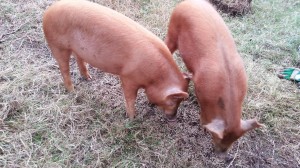
Four weeks on from the previous pig measurement session seems like a good time to check on the progress of our two Tamworth weaners.
By doing this it also brings home that they will not be with us for too much longer if we meet the planned schedule for taking them to slaughter in early/mid November at about 26 weeks.
In 2 months or less there will be no more tramping off to the woods twice a day with a bucket of pig feed which will be good. However it also means that one of the best bits about having them – the “pig watching” moments – will also come to an end.
To distract myself from any melancholy feelings, I’m focusing on the great meat they will provide us, the sausages and bacon we can make and I’m also thinking about the next 2 or 3 weaners we plan to get in spring next year.
Our resolve to raise our own animals for meat will have been tested for the first time and hopefully we will have risen to the challenge
The 19 week weigh-in
The same calculation for pig weight from metric measurements applies and I’ve included it below for easy reference::
Heart Girth ² x Length x 69.3
This time I decided to measure up each pig separately as they’re getting that much older but as we have not given either of them specific “pet” names I’ll resort to temporary names based on their physical appearance – Twirly and No Tail – although the difference is not visible in the picture above
Twirly
Heart Girth (measuring around the body just behind the front legs) = 0.78 m
Length (measured from between the ears to the base of the tail) = 0.96 m
This means that the approximate weight is: (0.78 ² x 0.96 x 69.3) = 40.48 kg
No Tail
Heart Girth (measuring around the body just behind the front legs) = 0.81 m
Length (measured from between the ears to the base of the tail) = 0.94 m
This means that the approximate weight is: (0.81 ² x 0.94 x 69.3) = 42.7 kg
Conclusion
Rather unexpectedly, the “Twirly” pig is slightly behind the other despite apparently being slightly larger when we first got them. However, allowing for discrepancies as a result of my measuring skills, the difference is negligible particularly since this is only a rough estimate to monitor progress.
Although I have no past experience to go by, I’m still hoping that they will be around 60-65kg by the time they go to slaughter if all goes to plan. We’ve supplemented their food from time to time with the occasional cabbage (including juicy caterpillars) and reduced their pig feed ration a little to compensate particularly as they have such a wonderful spot in the woods to root around in.
It’s possible that our inexperience means we’ve over estimated the reduction in feed and they’re certainly keen to get their food each meal time but they don’t look or feel malnourished and I can vouch for their weight as they often stand on my toes when I’m feeding them!